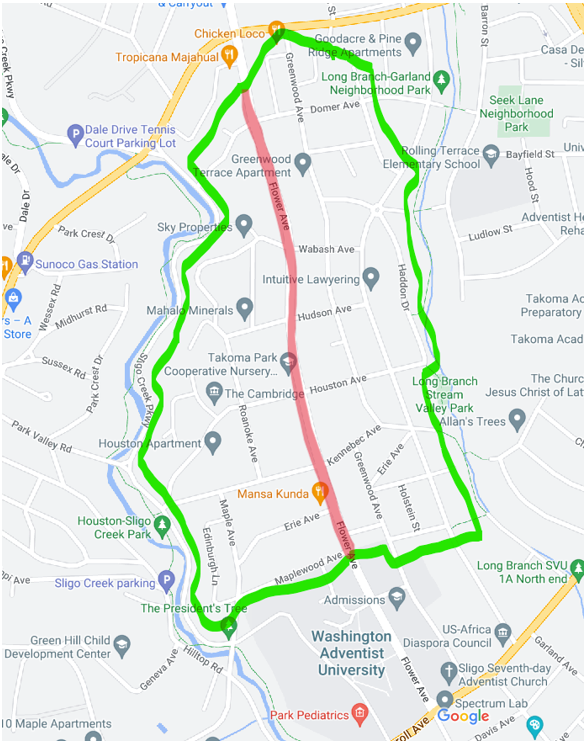Guest column by Salim Furth.
Relatively tight rent regulation has been in place in the City of Takoma Park since 1981, although the specifics of the law have changed several times. As a result, a significant share of the city’s rental stock has been converted to condominiums. I studied a relatively affordable part of the little city, and found that rent stabilization led to the condo conversion of 15% of rental buildings.
Those lost rental buildings aren’t being replaced by new construction. As Adam noted in a previous post, Takoma Park hasn’t built a single multifamily structure for decades.
Results
I compared the city-regulated blocks on the west side of Flower Avenue to the unincorporated, county-regulated blocks on the east side (see the map of the study area below). They’re indistinguishable and largely have access to the same public services and amenities.
On the county side, I found 41 multifamily buildings, all of them rentals. On the city side, I found 42 multifamily buildings. Six have been converted to condos. A seventh (Sligo Station) was built as a condominium in 1982.
Setting the last aside, that implies that 15 percent of rental buildings affected by rent regulation converted to condos. This effect is in line with academic studies of rent regulation.
(I cannot count the number of units in each building, so the percent of housing units might be a little higher or lower. Most rental buildings in this area have about six units).

What about the rest of the city?
Flower Avenue is one of Takoma Park’s lowest-priced neighborhoods. It’s relatively far from the Metro and boutique shopping district. Rolling Terrace ES, which serves the entire study area, isn’t as highly reputed as the schools that serve the more affluent parts of the city.
Multifamily housing in the Metro-convenient parts of the city has probably had more demand growth since 1981 – and thus more pressure to convert to condos. The rest of the city also features large, multistory buildings, which have different management economics than the six-plexes common around Flower Avenue.
Regardless of the exact percentage, condo conversions are common throughout the city. The county used its Right of First Refusal in 2017 to ensure 610-612 Kennebec remained a rental property and again in 2018 to buy 7906 Flower Avenue. And one of the biggest buildings in Takoma Park, Takoma Overlook, was recently converted.
I was first alerted to the potential risks of rent control in my neighborhood when a 12-unit rental building was listed for sale and priced like a tear-down. Whether that takes place or not, the city’s aging multifamily stock needs reinvestment and renewal; current policies have made that functionally impossible.
Appendix: Causation, not just correlation
My academic discipline, economics, has strict standards for claiming that “A causes B”. One way to identify causality is to find a natural experiment, such as a boundary that arbitrarily separates two otherwise-identical places such as Flower Avenue, which divides the City of Takoma Park from unincorporated Montgomery County.
Most city services, such as the city library, are open to non-City residents.
What does change at the border?
- City property owners pay higher taxes
- City residents can vote in city elections
- Trash collection is undertaken by a different agency
- Police protection is provided by a different agency
Is there a major factor I’m missing? I interviewed a dozen passersby in the neighborhoods surrounding Flower Ave. Only one could correctly identify the boundary. Postal addresses on both sides use the name “Takoma Park”, so most people on both sides – including the local postal worker – identified both sides as part of Takoma Park.
The biggest risk to this identification strategy is that, for most of the 1981-2023 period, property taxes were deductible from income for federal income tax purposes. This would soften the cost of city taxes for condo owners but not most rental owners.
Salim Furth is a housing economist and Takoma Park resident. He holds a Ph.D. from the University of Rochester.
